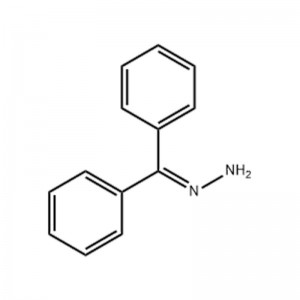
Products
Rna Uracil China Benzophenone Hydrazone Manufacture Supplier – Longo Detail:
Structural Formula

Physical
Appearance: white crystalline powder
Density: 1.1
Melting point: 95-98 °C (lit.)
Boiling point: 225-230 °C/55 mmHg (lit.)
refractivity: 1.5014 (estimate)
Flash point: 146 °C
Safety Data
general
Application
Used as organic pigments and pharmaceutical intermediates
Production Methods
Emergency response to a spill
Personnel protection, protective equipment and emergency procedures: It is recommended that emergency personnel wear respirators, anti-static clothing and rubber oil resistant gloves.
Do not touch or cross the spill.
All equipment used during operation should be earthed.
Disconnect the source of the spill if possible.
Eliminate all sources of ignition.
Define a cordoned area according to the area affected by liquid flow, vapour or dust dispersion and evacuate any uninvolved persons to a safe area from the side and upwind direction.
Environmental protection measures.
Contain the spill to avoid contamination of the environment. Prevent spills from entering sewers, surface water and groundwater.
Methods of containment and removal of spilled chemicals and disposal materials used: Small spill: Collect spilled liquid in a sealable container if possible. Absorb with sand, activated charcoal or other inert material and move to a safe place. Flushing into sewers is prohibited. Large spills: Construct an embankment or dig a pit to contain it. Seal drainage pipes. Cover with foam to inhibit evaporation. Transfer to tanker or special collector with explosion-proof pump and recycle or transport to waste treatment site for disposal.
Handling disposal and storage
Operating precautions:
Operators should be specially trained and follow strict operating procedures.
Handling and disposal should be carried out in a place with local or general ventilation.
Avoid eye and skin contact and inhalation of vapours.
Keep away from fire and heat sources and smoking is strictly prohibited in the workplace.
Use explosion-proof ventilation systems and equipment.
If tanking is required, control the flow rate and have an earthing device to prevent static build-up.
Avoid contact with forbidden substances such as oxidising agents.
Handle gently to prevent damage to packaging and containers.
Emptying containers may leave residues of harmful substances.
Wash hands after use and prohibit eating and drinking in the workplace.
Equip with the appropriate variety and quantity of fire-fighting equipment and spill response equipment.
Storage precautions:
Store in a cool, ventilated store.
Store separately from oxidising agents and edible chemicals and do not mix.
Keep containers sealed.
Keep away from fire and heat sources.
Lightning protection equipment must be installed in the storage room.
The exhaust system should be equipped with a grounding device to conduct static electricity.
Use explosion-proof lighting and ventilation settings.
The use of spark-prone equipment and tools is prohibited.
The storage area should be equipped with emergency spill handling equipment and suitable shelter materials.
Product detail pictures:

Related Product Guide:
Our crew through skilled training. Skilled skilled knowledge, strong sense of company, to meet the company wants of customers for Rna Uracil China Benzophenone Hydrazone Manufacture Supplier – Longo , The product will supply to all over the world, such as: Japan, Germany, Mexico, With a team of experienced and knowledgeable personnel, our market covers South America, the USA, the Mid East, and North Africa. Many customers have become our friends after good cooperation with us. If you have the requirement for any of our goods, make sure you contact us now. We're looking forward to hearing from you soon.
Wide range, good quality, reasonable prices and good service, advanced equipment, excellent talents and continuously strengthened technology forces,a nice business partner.






